| Parque de los Pobladores | |
|---|---|
 | |
 | |
| Location | San Jose, California |
| Coordinates | 37°21′08″N121°53′04″W / 37.3523°N 121.8845°W |
| Area | .2 acres (0.081 ha) [1] |
Parque de los Pobladores is a park in the SoFA District of Downtown San Jose, California.
| Parque de los Pobladores | |
|---|---|
 | |
 | |
| Location | San Jose, California |
| Coordinates | 37°21′08″N121°53′04″W / 37.3523°N 121.8845°W |
| Area | .2 acres (0.081 ha) [1] |
Parque de los Pobladores is a park in the SoFA District of Downtown San Jose, California.

In 1997, the Monument to the Founding of the Pueblo de San José de Guadalupe was erected in the park. The monument, designed by the East Los Streetscapers, commemorates the city's founders that came on Anza Expedition of 1776 that established the city as the California's first civilian settlement. [2] [3]
The park was redeveloped in 2012 to its current state, as part of the city's Pavement to Plaza program. [4]
In 2017, an art installation called "Urban Rooms" was installed at the park, designed by Estudio Teddy Cruz + Forman. [5] [6]
Parque de los Pobladores is located at the heart of the SoFA District of Downtown San Jose, at the intersection of Market Street and South 1st Street.
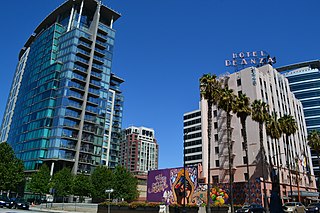
San Jose, officially the City of San José, is the cultural, financial, and political center of Silicon Valley and the largest city in Northern California, by both population and area.

The Guadalupe River mainstem is an urban, northward flowing 14 miles (23 km) river in California whose much longer headwater creeks originate in the Santa Cruz Mountains. The river mainstem now begins on the Santa Clara Valley floor when Los Alamitos Creek exits Lake Almaden and joins Guadalupe Creek just downstream of Coleman Road in San Jose, California. From here it flows north through San Jose, where it receives Los Gatos Creek, a major tributary. The Guadalupe River serves as the eastern boundary of the City of Santa Clara and the western boundary of Alviso, and after coursing through San José, it empties into south San Francisco Bay at the Alviso Slough.
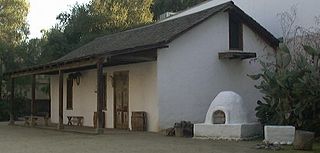
The Peralta Adobe is the oldest building in San Jose, northern California, still standing today. The adobe was built in 1797, and is named after Luis María Peralta, its most famous resident. The original builder was probably Manuel González.
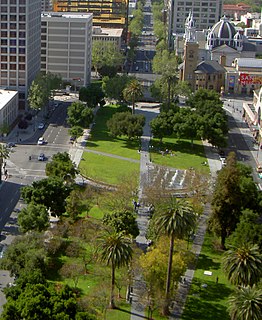
The Plaza de César Chávez is an urban plaza and park in Downtown San Jose, California, in Silicon Valley. The plaza's origins date to 1797 as the plaza mayor of the Spanish Pueblo de San José de Guadalupe, making it the oldest public space in Northern California. The plaza was reconsecrated after Californian civil rights activist César Chávez in 1993.
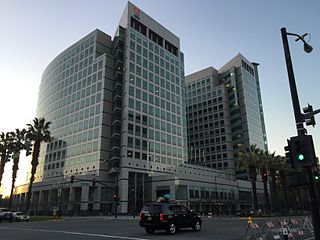
Downtown San Jose is the central business district of San Jose, California, in Silicon Valley. It is the largest urban center of Silicon Valley. Downtown is one of the largest tech clusters in Silicon Valley, as well as the cultural and political center of San Jose.
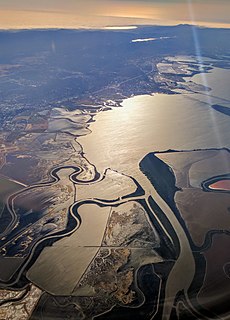
Coyote Creek is a river that flows through the Santa Clara Valley in California, United States.
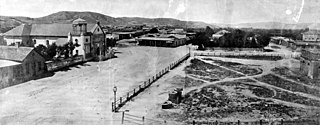
El Pueblo de Nuestra Señora la Reina de los Ángeles, shortened to Pueblo de los Ángeles, was the Spanish civilian pueblo settled in 1781, which by the 20th century became the American metropolis of Los Angeles. The pueblo was built using labor from the adjacent village of Yaanga and was totally dependent on local Indigenous labor for its survival.
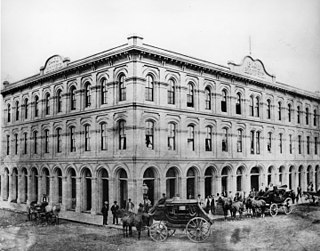
The Pico House is a historic building in Los Angeles, California, dating from its days as a small town in Southern California. Located on 430 North Main Street, it sits across the old Los Angeles Plaza from Olvera Street and El Pueblo de Los Ángeles Historical Monument.
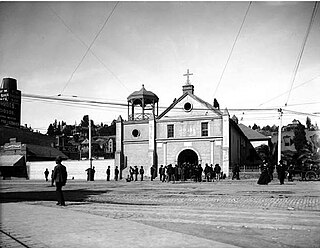
La Iglesia de Nuestra Señora la Reina de los Ángeles,, is a historic Roman Catholic church in El Pueblo de los Ángeles Historical Monument in northern downtown Los Angeles, California, United States. The church was founded by the Spanish in the early 19th century when modern-day California was under Spanish rule and known as Alta California in the Viceroyalty of New Spain.
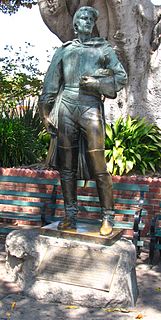
Felipe de Neve y Padilla (1724–1784) was the fourth governor of Las Californias, a province of New Spain, from 1775 to 1782. Felipe de Neve is considered a founder of Los Angeles, California and helped to settle towns of Santa Barbara and San José whose surrounding communities became California cities. In 1781, de Neve issued the first rules regarding governance of secular pueblos like Los Angeles, the "Regulations for the Government of the Province of the Californias"

The history of San Jose, California, the third largest city in the state, and the largest of all cities in the San Francisco Bay Area and Northern California, with a population of 1,021,795:
Los pobladores del pueblo de los Ángeles refers to the 44 original settlers and 4 soldiers who founded the Pueblo de Nuestra Señora la Reina de los Ángeles in 1781, which is now the present-day city of Los Angeles, California.

San José City Hall is the seat of the municipal government of San Jose, California. Located in Downtown San Jose, it was designed by Pritzker Prize-winning architect Richard Meier in a Postmodern style. It consists of an 18-story tower, an iconic glass rotunda, and a city council chamber wing, laid out within a two-block-long public square known as San José Civic Plaza. The tower rises 285 feet (87 m) above the plaza, making it the second tallest building in San Jose.

The El Pueblo de Los Ángeles Historical Monument, also known as Los Angeles Plaza Historic District and formerly known as El Pueblo de Los Ángeles State Historic Park, is a historic district taking in the oldest section of Los Angeles, known for many years as El Pueblo de Nuestra Señora la Reina de los Ángeles del Río de Porciúncula. The district, centered on the old plaza, was the city's center under Spanish (1781–1821), Mexican (1821–1847), and United States rule through most of the 19th century. The 44-acre park area was designated a state historic monument in 1953 and listed on the National Register of Historic Places in 1972.

Rancho Los Feliz was a 6,647-acre (26.90 km2) Spanish land concession in present-day Los Angeles County, California given in 1795 by Spanish Governor Pedro Fages to José Vicente Feliz. The land of the grant includes Los Feliz and Griffith Park, and was bounded on the east by the Los Angeles River.

Pershing Square is a small public park in Downtown Los Angeles, California, one square block in size, bounded by 5th Street to the north, 6th Street to the south, Hill Street to the east, and Olive Street to the west. It lies atop a large underground parking garage.

SoFA is an arts, cultural, and entertainment district of Downtown San Jose, California. Home to numerous cultural institutions, art galleries, and theatre companies, including the San Jose Institute of Contemporary Art, the San José Opera, and the Silicon Valley Symphony, SoFA bills itself as "Silicon Valley's Creative District".
Jose Vicente Feliz was a member of the 1775-76 Anza expedition that brought the first settlers to California. In 1781, he was one of four soldiers which guarded the settlers which founded the settlement of El Pueblo de Nuestra Señora la Reina de los Ángeles, which would become Los Angeles. He took on a leadership role in the founding and governance of that pueblo, in essence becoming the city's first mayor, and was rewarded for his efforts with a Spanish land grant in the hills above Los Angeles, in the area of what today still bears his name: Los Feliz.
| Wikimedia Commons has media related to Parque de los Pobladores . |